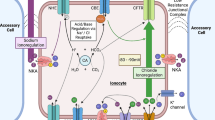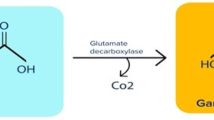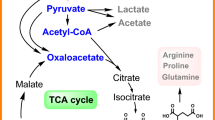Abstract
Glutamic acid was found to be growth inhibitory to a murinelymphocyte hybridoma in a concentration-dependent manner from 3to 12 mM glutamate. At 12 mM glutamate there was a 70% decreasein the specific growth rate of the cells. Attempts to alleviateinhibition or adapt cells to growth in glutamate-based mediawere unsuccessful. It is proposed that elevated glutamate levelsimpair adequate uptake of cystine, a critical amino acid for thesynthesis of glutathione. Glutathione is required by cells toprevent intracellular oxidative stress. The measured rate ofuptake of U-14C L-cystine into the cells was found to havethe following parameters: Km = 0.87 mM, Vmax = 0.9nmole/mg cell protein per min. The uptake was sodiumindependent and resembled the previously described x- ctransport system, with elevated glutamate levels causingextensive inhibition. Glutamate at a concentration of 1.4 mMcaused a 50% decrease in cystine uptake from the serum-freegrowth medium. Glutamate was taken up from the external medium(Km = 20 mM and Vmax = 12.5 nmole/mg cell protein permin) by the same transport system in a stereo specific, sodiumindependent manner. Of the amino acids examined, it was foundthat cystine and homocysteic acid were the most extensiveinhibitors of glutamate uptake and that inhibition was competitive. Metabolic profiles of the cells grown in culturescontaining enhanced glutamate levels revealed an overallincrease in net production of alanine, serine, asparagine andaspartate. A substantially increased specific consumption ofglutamate was accompanied by a decreased consumption of cystine,valine and phenylalanine.The combined kinetic and metabolic results indicate thatglutamate and cystine are taken up by the anionic transportsystem x- c. The increasing levels of glutamate in themedium result in a decreased transport of cystine by this systemdue to competitive inhibition by glutamate.
Similar content being viewed by others
References
Ash JF, Igo Jr RP, Morgan M and Grey A (1993) Selection of Chinese Hamster Ovary cells (CHO-K1) with reduced glutamate and aspartate uptake. Som Cell Mol Gen 19: 231-243.
Bannai S and Kitamura E (1981) Role of proton dissociation in the transport of cystine and glutamate in human diploid fibroblasts in culture. J Biol Chem 256: 5770-5772.
Bannai S and Kitamura E (1980) Transport interaction of L-cystine and L-glutamate in human diploid fibroblasts in culture. J Biol Chem 255: 2372-2376.
Bannai S and Tateishi N (1986) Role of membrane transport in the metabolism and function of glutathione in mammals. J Membrane Biol 89: 1-8.
Bannai S (1986) Exchange of cystine and glutamate across plasma membrane of human fibroblasts. J Biol Chem 261: 2256-2263.
Bannai S (1984) Transport of cystine and cysteine in mammalian cells. Biochim Biophys Acta 779: 289-306.
Bannai S, Tsukeda H and Okumura H (1977) Effect of antioxidants on cultured human diploid fibroblasts exposed to cystine-free medium. Biochem Biophys Res Commun 74: 1582-1588.
Bannai S and Ishii T (1988) A novel function of glutamine in cell culture: Utilization of glutamine for the uptake of cystine in human fibroblasts. J Cell Physiol 137: 360-366.
Bannai S (1984) Transport of cystine and cysteine in mammalian cells. Biochem Biophys Acta 779: 289-306.
Bannai S and Kitamura E (1982) Adaptive enhancement of cystine and glutamate uptake in human diploid fibroblasts in culture. Biochim Biophys Acta 721: 1-10.
Barnabé N and Butler M (1994) Effect of temperature on nucleotide pools and monoclonal antibody production in a mouse hybridoma. Biotech Bioeng 44: 1235-1245.
Bebbington CR, Renner G, Thomson S, King D, Abrams D and Yarranton GT (1992) High-level expression of a recombinant antibody from myeloma cells using a glutamine synthetase gene as an amplifiable selectable marker. Bio/Technology 10: 169-175.
Birwe H and Hesse A (1991) High-performance liquid chromatographic determination of urinary cysteine and cystine. Clin Chimica Acta 199: 33-42.
Bray HG, James SP, Raffau IM and Thorpe WV (1949) The enzymatic hydrolysis of glutamine and its spontaneous decomposition in buffer solutions. Biochem J 44: 625-627.
Burger M, Hess MW and Cottier H (1982) The role of 2-mercaptoethanol in the stimulation of spleen cell cultures: increased uptake of cystine into the TCA-soluble pool. Immunol Lett. 4: 193-197.
Butler M and Christie A (1994). Adaptation of mammalian cells to non-ammoniagenic media. Cytotechnology 15: 87-94.
Butler M, Imamura T, Thomas J and Thilly WG (1983) High yields from microcarrier cultures by medium perfusion. J Cell Sci 61: 351-363.
Butler M and Jenkins H (1989) Nutritional aspects of growth of animal cells in culture. J Biotechnol 12: 97-110.
Butler M and Spier RE (1984) The effects of glutamine utilisation and ammonia production on the growth of BHK cells in microcarrier cultures. J Biotechol 1: 187-196.
Christensen HN and Kilberg MS (1987) Amino acid transport across the plasma membrane: role of regulation in interorgan flow. In: Amino acid transport in Animal Cells. DL Yudilevich and CAR Boyd, eds. Manchester University Press, Manchester UK. pp. 10-46.
Christie A and Butler M (1994). Glutamine-based dipeptides are utilized in mammalian cell culture by extracellular hydrolysis catalyzed by a specific peptidase. J Biotechnol 37: 277-290.
Christie A and Butler M (1999) The adaptation of BHK cells to a non-ammoniagenic glutamate-based culture medium. Biotech Bioeng in press.
Cotgreave LA and Schuppe-Koistinen I (1994) A role for γ-glutamyl transpeptidase in the transport of cystine into human endothelial cells; relationship to intracellular glutathione. Biochim Biophys Acta 1222: 375-382.
Dall'Asta V, Gazzola GC, Gazzola R, Bussolati O, Longo N and Guidotti GG (1983) Pathways of L-glutamic acid transport in cultured human fibroblasts. J Biol Chem 258: 6371-6379.
Deneke SM (1992) Induction of cystine transport in bovine pulmonary artery endothelial cells by sodium arsenite. Biochim Biophys Acta 1109: 127-131.
Fedorcsak I, Harms-Ringdahl M and Ehrenberg L (1977) Prevention of sulfhydryl autoxidation by a polypeptide from red kidney beans, described to be a stimulator of RNA synthesis. Exp Cell Res 108: 331-339.
Forster S and Lloyd JB (1985) pH-profile of cystine and glutamate transport in normal and cystinotic human fibroblasts. Biochim Biophys Acta 814: 398-400.
Glacken MW (1988) Catabolic control of mammalian cell culture. Bio/Technology 6: 1041-1049.
Hassell T and Butler M (1990). Adaptation to non-ammoniagenic medium and selective substrate feeding lead to enhanced yields in animal cell cultures. J Cell Sci 96: 501-508.
Ishii T, Hishinuma I, Bannai S and Sugita Y (1981) Mechanism of growth promotion of mouse lymphoma L 1210 cells in vitro by feeder layer or 2-mercaptoethanol. J Cell Physiol 107: 283-293.
Jones BN and Gilligan JP (1983) o-Phthaldialdehyde pre-column derivatization and reversed-phase high-performance liquid chromatography of polypeptide hydrolyzates and physiological fluids. J Chromatogr 266: 471-482.
Lee TC, Wei ML, Chang WJ, Ho IC, Lo JF, Jan KY and Huang H (1989) Elevation of glutathione levels and glutathione S-transferase activity in arsenic-resistant Chinese hamster ovary cells. In Vitro Cell Dev Biol 25: 442-448.
Ljunggren J and Haggstrom L (1990) Glutamine limited fed-batch culture reduces ammonium ion production in animal cells. Biotechnol Lett 12: 705-710.
Makowske M and Christensen HN (1982) Contrasts in transport systems for anionic amino acids in hepatocytes and a hepatoma cell line HTC. J Biol Chem 257: 5663-5670.
McDermott RH and Butler M (1993) Uptake of glutamate, not glutamine synthetase, regulates adaptation of mammalian cells to glutamine-free medium. J Cell Sci 104: 51-58.
Meredith MJ and Williams GM (1986) Intracellular Glutathione cycling by γ-glutamyl transpeptidase in tumorigenic and non-tumorigenic cultured rat liver cells. J Biol Chem 261: 4986-4992.
Murphy TH, Miyamoto M, Sastre A, Schnaar RL and Coyle JT (1989) Glutamate toxicity in a neuronal cell line involves inhibition of cystine transport leading to oxidative stress. Neuron 2: 1547-1558.
Ohmori H and Yamamoto I (1983a) Mechanism of augmentation of the antibody response in vitro by 2-mercaptoethanol in murine lymphocytes: II. A major role of the mixed disulfide between 2-mercaptoethanol and cysteine. Cell Immunol 79: 173-185.
Ohmori H and Yamamoto I (1983b) Mechanism of augmentation of the antibody response in vitro by 2-mercaptoethanol in murine lymphocytes: III. Serum-bound and oxidized 2-mercaptoethanol are available for the augmentation. Cell Immunol 79: 186-196.
Ohmori H and Yamamoto I (1982) Mechanism of augmentation of the antibody response in vitro by 2-mercaptoethanol in murine lymphocytes. I. 2-Mercaptoethanol-induced stimulation of the uptake of cystine, an essential amino acid. J Exp Med 155: 1277-1290.
Patterson MK Jr (1979) Measurement of growth and viability of cells in culture. Methods Enzymol 58: 141-152.
Petch D and Butler M (1994) A profile of energy metabolism in a murine hybridoma: glucose and glutamine utilization. J Cell Physiol 161: 71-76.
Petch D and Butler M (1996). The effect of alternative carbohydrates on the growth and antibody production of a murine hybridoma. Appl Biochem Biotech 59: 93-104.
Ratan RR, Murphy TH and Baraban IM (1994) Macromolecular synthesis inhibitors prevent oxidative stress induced apoptosis in embryonic corticol neurons by shunting cysteine from protein synthesis to glutathione. J Neurosci 14: 4385-4392.
Reynolds RA, Mahoney SG, McNamara PD and Segal S (1991) The influence of pH on cystine and dibasic amino acid transport by rat renal brush border membrane vesicles. Biochim Biophys Acta 1074: 56-61.
Rosenberg LE and Downing S (1965) Transport of neutral and dibasic amino acids by human leukocytes. J Clin Invest 44: 1382-1393.
Sano K (1926) Solubility of amino acids under the influence of different pH. Biochem Z 168: 14-33.
Sato H, Takenaka Y, Fujiwana K, Yamaguchi M, Abe K and Bannai S (1995). Increase in cystine transport activity and glutathione level in mouse peritoneal macrophages exposed to oxidized low density lipoprotein. Biochem Biophys Res Comm 215: 154-159.
Schroer JA, Bender T, Feldman RJ and Kim KJ (1983) Mapping epitopes on the insulin molecule using monoclonal antibodies; Eur J Immunol 13: 693-700.
Tritsch GL and Moore GE (1962) Spontaneous decomposition of glutamine in cell culture media. Exp Cell Res 28: 360-364.
van Winkle LJ, Mann DF, Wasserlauf HG and Patel M (1992) Mediated Na+-independent transport of L-glutamate and L-cystine in 1-and 2-cell mouse conceptuses. Biochim Biophys Acta 1107: 299-304.
Wice BM, Reitzer LJ and Kennell D (1981) The continuous growth of vertebrate cells in the absence of sugar. J Biol Chem 256: 7812-7819.
Zielke HR, Zielke CL and Ozand PT (1984) Glutamine: a major energy source for cultured mammalian cells. Fed Proc 43: 121-125.
Author information
Authors and Affiliations
Rights and permissions
About this article
Cite this article
Broadhurst, E., Butler, M. The inhibitory effect of glutamate on the growth of a murine hybridoma is caused by competitive inhibition of the x- C transport system required for cystine utilization. Cytotechnology 32, 31–43 (2000). https://doi.org/10.1023/A:1008143716374
Issue Date:
DOI: https://doi.org/10.1023/A:1008143716374




